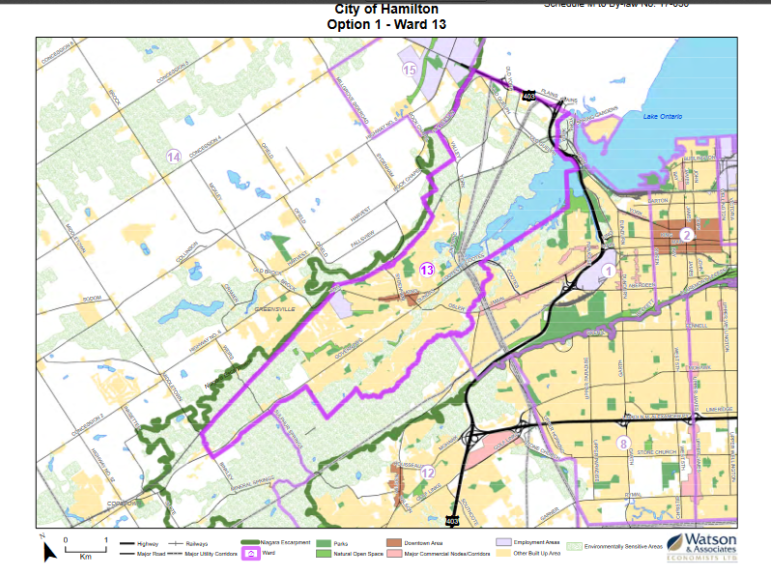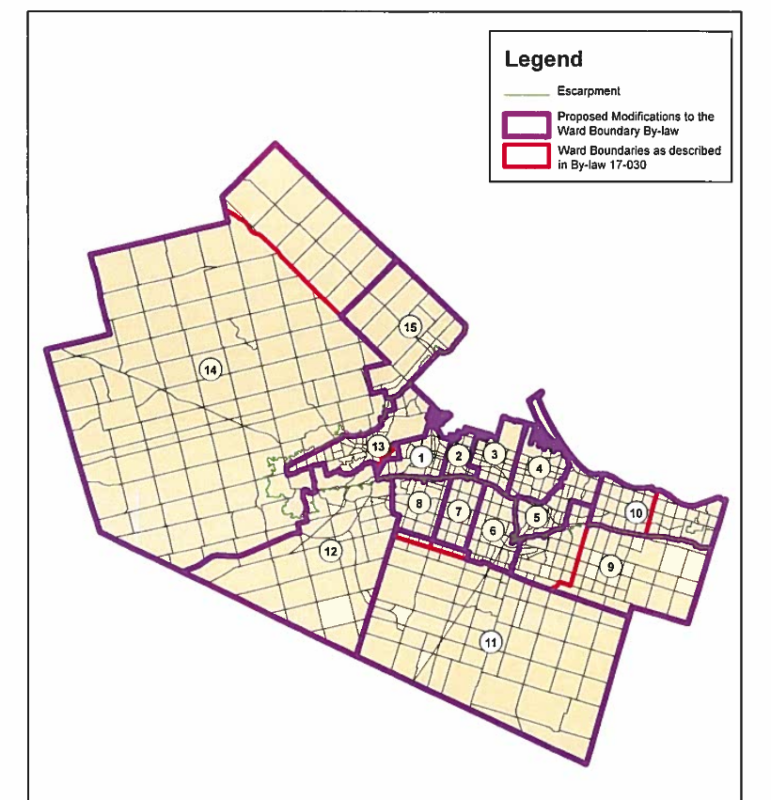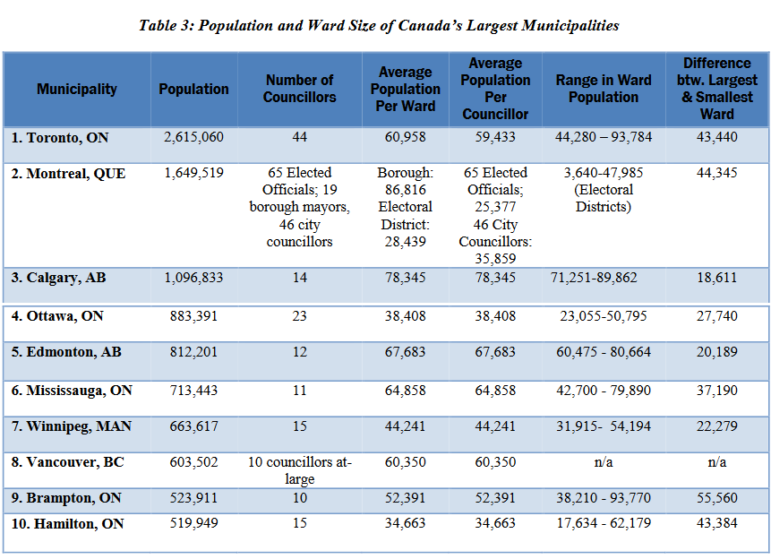Ward 13 (Dundas and West Flamborough) City Council candidate John Mykytyshyn tells Hamilton Community News that if elected, he’ll “work tirelessly to have Dundas have its own ward again”.
In TPR’s first issues analysis piece, I’ll look at what Mykytyshyn’s promise means, and what he’ll need to do to implement the promise.
First some brief background.
The Town of Dundas was incorporated in 1847, and for a time surpassed the economic activity of Hamilton, enabling the Town to create its own unique institutions (such as its own Carnegie Library which today is the Carnegie Gallery) and identity separate from City of Hamilton. Dundas was an independent Town until 2001 when it was involuntarily amalgamated into the new single-tier City of Hamilton.
As part of amalgamation, Dundas (and other suburban municipalities) were granted disproportional representation on City Council as part of what was to be a short-term political compromise to alleviate concerns about lost identity and independence. Dundas was granted its own seat on Council as part of this temporary arrangement.
For 15 years, successive Councils deferred addressing ward boundaries, leaving the temporary boundaries in place. In 2012, over 1000 residents signed a petition calling on Council to review ward boundaries. Council voted to begin a review in 2015. In April 2015, Council voted 8-8 to only receive a staff report on ward boundaries to begin the review. A tie vote fails, meaning the status quo prevails. In this instance, because Council had previously directed the review to occur, the review happened.
The Law of Ward Boundaries in Hamilton
In October 2016, Watson and Associates filed its ward boundary review report. Council rejected the report, and sent the consultants back to create ward boundaries suggested by the Council which attempted to maintain the status quo, including maintaining Dundas as its own ward.

In September 2017, just weeks before an Ontario Municipal Board hearing into the Council approved wards, Council amended them further in a last second attempt to save their own ward proposal.
The Council amended boundaries shaved off slivers of Ward 1’s Ainslie Wood neighbourhood to increase the population of Dundas. It was this attempt to increase the population of Ward 13 that was the crux of the OMB’s overturning Council’s amended wards.
OMB Executive Chair Dr. Bruce Krushelnicki wrote the slicing of Ainslie Wood to add population to Dundas was “as an unreasonable error which divides a community of interest without apparent justification” because it divided a functional neighbourhood, and diluted the ability of the student and renter populations of those Ainslie Wood to obtain effective representation.
Those groups would represent around 10% of the new Dundas ward, and have interests which would significantly differ from the core of Dundas, and due to their small proportion of the ward, they could be ignored by the Dundas Councillor.

A reasonable person can ask: don’t the interests of Dundas significantly differ from those of rural Flamborough?
So why would those two interests be grouped in one ward when the OMB ruled Dundas could not be combined with slivers of Ainslie Wood?
The key difference is in the new Ward 13, neither interest can dominate the other.
There is effectively no path to winning the new Ward 13 that does not involve serving the interests of both urban Dundas and rural Flamborough.
A candidate cannot run a campaign focused solely on the narrow interests of one half of the Ward as neither group possesses enough votes on its own to dominate the ballot box and elected their “own” Councillor.
There’s an argument to be made that having a Councillor who must weight various interests in the ward they represent makes for better governance for the City of Hamilton as they cannot solely take a narrower urban or rural view.

How to Make Dundas Its ‘Own Ward’
Dundas lacks sufficient population to be its own ward in a 15-member Hamilton City Council.
Representation by population is an important concept in electoral democracies, especially in local politics. What are acceptable disparities in ward populations?
The OMB Hamilton wards decision tackled this in paragraphs 152 to 171, stating the new wards “strikes the appropriate balance. It achieves a high degree of population parity without slavishly adhering to some mathematical ideal”.
Based upon the questions asked by Executive Chair Dr. Krushelnicki during the hearing, the meaning of this statement is that representation by population is not an absolute, that there can be some variation in ward population sizes, but those variations must be for reasons of practically or minor voter protection – it cannot be for political convenience or deal-making.
The 2016 population of Dundas is 24,285, the total 2016 population of Hamilton is 536,930. With 15 wards, the average population per ward is 35,794.
Dundas is short by 11,500 of the population needed to obtain its own Council seat.
This provides two obvious policy means to make Dundas it’s own ward, and I’ll ask Mykytyshyn which he’s looking to implement: Mykytyshyn will need to increase the population of Dundas by at least 7,000 people or increase the number of City Councillors to 22.
In short, more high density mid-rise development (including demolition of existing single family homes and low-rise structures) or more politicians at Hamilton City Hall.
More Councillors on City Council?
To make Dundas its own ward, with its present population, will require increasing the number of Councillors to decrease the population per ward. To make Dundas a ward requires adding seven new Councillors.
Is adding more Councillors feasible, and would it reflect representation averages in comparable municipalities?
The Toronto Ward Boundary Review background report found the average population per ward for Canada’s 10 largest municipalities is 53,606. Hamilton was the lowest, Calgary the highest at 78,345. (Report page 26: Original Link, Archived on TPR)

Based on the data, one can reasonably argue that Hamilton already has too many politicians.
The public is unlikely to have much appetite for more politicians, and the fact that Hamilton has more municipal politicians per capita creates the opportunity for a populist to call for less politicians on Council.
Small Wards a Legacy of Amalgamation in Comparable Communities
Before we leave the ward populations discussion behind, the numbers reveal something more interesting – where people have traditionally been served by part-time ward councillors in smaller municipalities, it appears residents wish to continue to have access to their local politician at the neighbourhood level.
Hamilton, Ottawa, and Winnipeg are post-amalgamation cities. Both Hamilton and Ottawa were amalgamated in 2001. Winnipeg was amalgamated in 1972.
It’s been 18 years since amalgamation here in Hamilton, 47 years since amalgamation in Winnipeg.
Even with nearly 30 years longer as one city, the legacy of the former communities of Winnipeg continue to influence the composition and size of Winnipeg’s City Council. There are 15 wards in Winnipeg, the boundaries have a legacy in the former municipalities. The populations of the wards varies from 31,000 to 54,000 residents with an average of 44,000 residents per ward, nearly 10,000 people below the average of comparable municipalities.
I lived briefly in Winnipeg during the early-00s attending the University of Manitoba; it took only weeks for me to be told the stories of the former municipalities, and that I was living in the former Rural Municipality of Fort Garry. I would quickly learn of the other former municipalities whose community spirit continues to this day in their service clubs and curling clubs. I was a student member of the Kiwanis Club of Fort Garry, and regularly attended the Kiwanis Club in Kildonan.
The community of Dundas has multiple Rotary Clubs, it’s own archives and museum, and a host of other cultural institutions which serve to maintain the vibrancy of its community. These are what define a community.
The sentiment for a Dundas ward is a reasonable one, however with the current population of Dundas is not practical. Under a 15 ward system, the OMB has ruled it illegal.
More Development in Dundas to Increase Population by 25%
For the purposes of analyzing this issue, let’s look at the alternative to increasing the number of politicians, that is to increase the population of the town of Dundas by approximately 33% to bring it to the average ward size of Hamilton. To achieve a population level which would allow Dundas to have it own ward with 10% less than average population, Dundas will need to grow its population by approximately 25%
The residents of Dundas are not likely to support such a huge amount of growth; in fact many residents of Dundas delegated in front of City Council numerous times expressing concerns about the current growth trends in Dundas, such as the development of mid-rise buildings and demolition of smaller buildings.
A nine-storey development at 71 Main Street in Dundas was a major lightning rod during the 2014 municipal election. When Council voted 9-6 in favour of the development (page 9, December 9, 2015 City Council minutes), after City planning staff stated it met the requirements of the Provincial Growth Plan, a group of Dundas residents came together to successfully fund-raise for an OMB appeal which is ongoing.
Hamilton’s growth projections expect new Hamiltonian’s will wish to settle in either the urban core areas well served by public transportation, or the new medium density suburban townhome developments that are planned for Upper Stoney Creek, Binbrook, and Waterdown. The projection are that the population of Dundas will slightly decrease in the coming decade.
Conclusion
In conclusion, there is no practical means of making Dundas its own ward again.
Mykytyshyn is a very smart man, a skilled political strategist, a person who knows the facts you just read.
His promise, it’s pandering.
Even the term he uses “work tirelessly” is not a promise to achieve making Dundas it’s own ward, just a promise to spend energy in a futile venture.
Mykytyshyn’s statement happens to be the first that The Public Record is critiquing; I hope other candidates take notice that new journalism is in Hamilton, and will be analysing their statements to ensure our readers are informed, and candidates are putting forth realistic ideas for the future of Hamilton.
